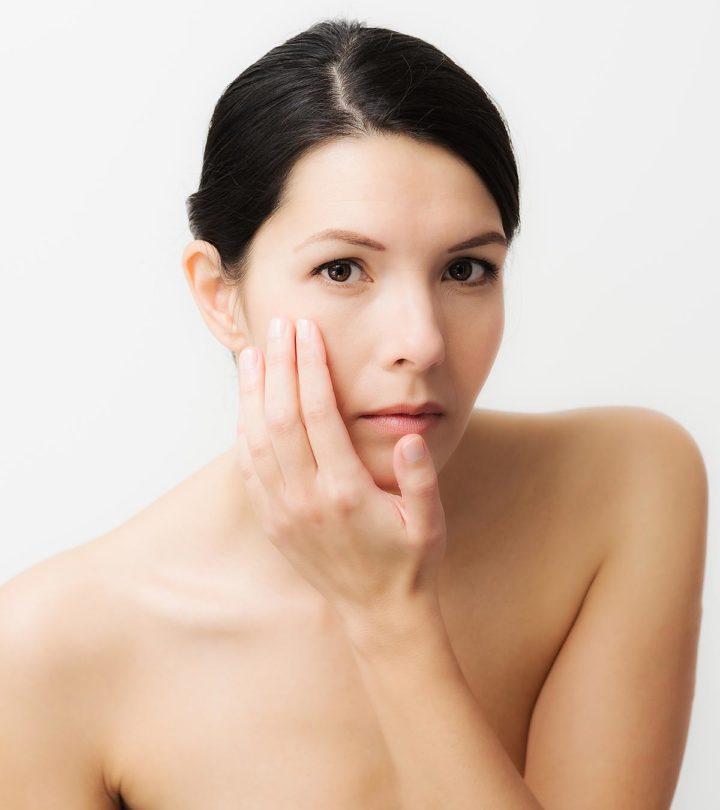How to Get Rid of Lines Under Eyes Teenager

Image: Shutterstock
Dark circles are one of the most common dermatological complaints and often associated with a lack of sleep, fatigue, and stress. The condition is characterized by excess pigmentation and blemishes around the eyes, especially under the lower eyelid (1).
The presence of dark circles is seldom a cause for concern, but it can be a cosmetic problem for teenagers. Keep reading this MomJunction post to know about causes, risk factors, and treatment options for dark circles in teenagers.
Symptoms Of Dark Circles In Teens
Dark circles can appear as light to dark-colored, brownish-black pigmentation around the eyes. They are generally classified into: (3).
- Pigmented: The area appears as a brown hue or tinge around the eyelid.
- Vascular: The area around the eyes appears as pink, purple, or blue hue with or without puffiness.
- Structural: The under-eye area appears darker due to shadows formed by the facial structures or contours.
Causes Of Dark Circles In Teens
Dark circles can occur in both boys and girls. There are several factors and conditions associated with the appearance of dark circles under the eyes (2) (3) (4) (5).
- Periorbital hyperpigmentation: Excess pigmentation under the eyes is often one of the main reasons for the presence of chronic or long-lasting dark circles. The condition is called periorbital hyperpigmentation. It can occur due to conditions such as dermal melanocytosis (a condition that causes blue-brown discoloration on the face) and post-inflammatory hyperpigmentation, which is due to allergic reactions or dermatitis. Dermatitis, also known as eczema, can cause dry and itchy skin. Excessive rubbing of the skin below the lower eyelid can cause this type of pigmentation.
- Thinness and translucence under-eye skin: Thin translucent skin under the lower eyelid can make the blood vessels more visible or prominent. This occurs due to low levels of fat under the skin, thus giving it a darker, bluish, or pinkish tinge. This condition can become more noticeable during menstruation in females.
- Genetics: Dark circles could run in families due to genetic predisposition to develop excess pigmentation under the lower eyelid. The condition might become more prominent as the child steps into the teen years. However, researchers have noted that pigmentation improves when the person is well-rested and has good health.
- Certain drugs: Some medicines, such as those for hormone replacement therapy, might cause the development of dark circles as a side effect.
[ Read: Sleep Disorders In Teens ]
The causes of dark circles extend beyond medical and physiological reasons. Certain environmental, physiological, and lifestyle-related factors might cause or worsen existing dark circles. Some common factors associated with dark circles are:
- Excessive exposure to the sun
- Ultraviolet radiation
- Lack of sleep
- Anemia (nutritional deficiencies)
- Smoking
- Alcohol consumption
- Hormonal disturbances
- Stress
- Dehydration
- Disorders of thyroid, liver, or kidney
- Excessive screen time and gadget use
[ Read: Dehydration In Teens ]
Risk Factors Of Dark Circles In Teens
A few factors can make a teen more susceptible to dark circles (4) (5).
- Ethnicity: It has been observed that individuals belonging to ethnic groups with a darker skin tone could be more prone to dark circles than those from groups with lighter skin.
- Genetics: Dark circles can run in the family, and a teen might have dark circles if other family members have it too.
- Age: Several changes occur in the skin during teenage. The phase might make the child more susceptible than when they were a young child.
How To Remove Dark Circles Naturally?
Home remedies for dark circles are mostly anecdotal and may not have scientific backing. Therefore, it is advisable to do a patch test before trying them under the dark circles if your child has sensitive skin or any existing skin problems.
You may try the following simple at-home remedies to manage your child's dark circles.
- Use a cold compress: Applying a cold compress can help constrict the dilated blood vessels, thus reducing the puffiness and alleviating dark circles.
- Get adequate sleep: Make sure your child gets quality and adequate sleep. This will help relieve stress and manage dark circles (6).
- Apply cold tea bags: Placing cold (refrigerated) and soaked tea bags under the eyes can help reduce dark circles. The caffeine content of the tea could constrict the blood vessels while also stimulating blood circulation. Its antioxidant properties can also be useful in managing the dark circles. You may boil herbal, green, or black tea bags and then refrigerated them for use (7).
- Keep your head elevated: During sleep, you may encourage your child to use a comfortable pillow to keep the head elevated. This may help reduce dark circles and puffiness under the eyes.
- Use sunscreen: Using a broad-spectrum sunscreen along with UV coated sunglasses can help manage pigmentation under the eyes (3). Pick sunscreens that are safe for application under the eye.
The use of cosmetic concealers and under-eye massage might help reduce the intensity of darkness. However, use caution since concealers can contain chemicals and massaging close to the eye can be risky.
[ Read: Dark Circles In Children ]
Medical Treatment For Dark Circles In Teens
Dark circles in teens seldom require any treatment. Your child's doctor might recommend home management tips and suggest waiting for the child to grow older. Dealing with the underlying cause, like inadequate sleep and UV exposure could help cure dark circles.
Treatment might usually be required only in cases where dark circles cause body image issues in teens. In such cases, a dermatologist might suggest the following treatment methods (3).
- Topical depigmentation agents can be used to reduce dark circles. These can include
- Hydroquinone in combination with tretinoin
- Kojic acid (naturally derived from naturally occurring Aspergillus fungi species)
- Azelaic acid
- Topical retinoic acid
- Topical vitamin C
- Arbutin (extract of leaves of the bearberry shrub and the cranberry, pear, or blueberry plants)
- Chemical peels and laser therapy do exist as treatment options. However, you should discuss these techniques with a skincare expert or dermatologist to work out the safer options for your child's age group.
It is advised never to self-medicate or use over-the-counter skin products without consultation with a doctor.
Prevention Of Dark Circles In Teens
Some causes of dark circles can be prevented by observing certain precautions and lifestyle changes.
- Have an adequate sleep.
- Have a balanced diet rich in fresh fruits with anti-oxidants to prevent nutritional deficiencies.
- Use appropriate sunscreens and wear sunglasses to protect from pigmentation and sun damage (UV rays).
- Discuss with your teen about ways to manage stress, which could cause fatigue and sleeplessness.
Dark circles are a common condition, and their impact is limited to cosmetic problems. Good sleep and other precautions can significantly help control the presence of dark circles. Speak to your teen and let them know that excess pigmentation around the eyes is nothing to be worried and conscious about. You can also consult a doctor to know about the ways to manage the issue.
[ Read: Eye Makeup For Teens ]
Have some experiences to share about dark circles in teens? Let us know your thoughts in the comment section below.
References:
MomJunction's articles are written after analyzing the research works of expert authors and institutions. Our references consist of resources established by authorities in their respective fields. You can learn more about the authenticity of the information we present in our editorial policy.
1. Ivan Vrcek, Omar Ozgur, and Tanuj Nakra,Infraorbital Dark Circles: A Review of the Pathogenesis, Evaluation and Treatment; Journal of Cutaneous and Aesthetic Surgery
2. Sheth P. B., Shah H. A., and Dave J. N., Periorbital hyperpigmentation: a study of its prevalence, common causative factors and its association with personal habits and other disorders; Indian Journal of Dermatology
3. Sarkar R. et al., Periorbital Hyperpigmentation: A Comprehensive Review; The Journal of Clinical and Aesthetic Dermatology
4. Roh M. R. and Chung K. Y., Infraorbital dark circles: definition, causes, and treatment options: Dermatologic Surgery
5. Roberts W. E., Periorbital hyperpigmentation: review of etiology, medical evaluation, and aesthetic treatment: Journal of Drugs in Dermatology
6. Sundelin T. et al., Cues of fatigue: effects of sleep deprivation on facial appearance: Sleep
7. Ahmadraji F. and Shatalebi M. A., Evaluation of the clinical efficacy and safety of an eye counter pad containing caffeine and vitamin K in emulsified Emu oil base. Advanced Biomedical Research
The following two tabs change content below.
- Reviewer
- Author

Dr. Shashidhar is a qualified pediatrician and neonatologist currently practicing at St John's Medical College and Tiny Tots Clinic in Koramangala, Bangalore. He is a part of an accomplished team taking care of preterm and sick newborns until discharge and follow up. He is a teacher at various levels from undergraduate to post-doctoral medical students. Keenly interested in different aspects... more

Dr. Bisny T. Joseph is a Georgian Board-certified physician. She has completed her professional graduate degree as a medical doctor from Tbilisi State Medical University, Georgia. She has 3+ years of experience in various sectors of medical affairs as a physician, medical reviewer, medical writer, health coach, and Q&A expert. Her interest in digital medical education and patient education made... more
How to Get Rid of Lines Under Eyes Teenager
Source: https://www.momjunction.com/articles/dark-circles-under-eyes-in-teenagers_00382614/